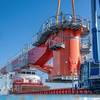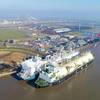New discoveries of giant oil and gas field discoveries offshore Brazil have operators venturing into deeper water while committing expanded E&P budgets for developments in frontier regions. The Campos Basin remains the greatest focus of exploratory activity, with the Santos Basin to the south and Espirito Santo Basin to the north also seeing activity.
Ship-shaped floating production, storage and off-loading (FPSO) vessels remain the preferred development option for these frontier prospects, with ABS the leading classification society of choice for FPSO conversions for offshore Brazil, says João Carlos Pacheco, ABS Brazil country manager.
“As an ABS representative in South America for nearly 20 of ABS’ 50-year-plus history in the region, I continue to be impressed by how Petrobras and industry participating in offshore Brazil adapt to changing needs. Brazil is on the forefront of offshore technology, especially, deepwater technology. ABS is proud to be a part of this frontier development and technology advancement,” said Pacheco.
By 2005, more than half of Brazil’s oil production will come from ultra-deep waters, requiring an incredible investment in infrastructure and involving untold risks, advises Pacheco.
“That has not stopped Petrobras; nor does it inhibit the international oil and gas companies which come to Brazil to help develop its rich offshore fields,” he said.
Elements of change and technology growth, says Pacheco, include the approach that is taken on projects:
More in-depth, up-front engineering work and review of designs;
Greater attention to risk and probabilistic studies for safety, viability and practicality of a design;
More demand for inspection services that are calibrated to the installation
and areas of special interest; and
Greater recognition for the role that classification can have for facilitating the
safety and integrity of an installation.
“These are the tools that help put a project together solidly and successfully, making a unit fit for its intended purpose,” said Pacheco. He advises that ABS is presently assisting the industry with the classification of five major FPSO conversion projects destined for offshore Brazil. The projects include the “FPSO Brasil”; the “Petrobras 43”; “Petrobras 48”; “Petrobras 50”; and the “Fluminense.” Each converted FPSO is an ABS-classed XA1 Floating Production Storage and Offloading Unit. And while the “FPSO Brasil” is the first FPSO to which the SafeHull Converted Ship Notation has been awarded, all of these converted FPSO units incorporate ABS SafeHull technology.
“The ABS SafeHull technology is the most advanced design and analysis tool for the evaluation of a vessel’s structure to classification standards that is available to industry today,” said Pacheco.
He adds that the recently enhanced capabilities of ABS SafeHull for FPSOs will assess the vessels for the relatively benign, site-specific conditions in Campos Basin. Using ABS SafeHull, he explains, a 25-year-old tanker can be evaluated to the same extent as a new-build vessel.
ABS’ scope of classification for an FPSO includes:
Review and approval of the FPSO design for compliance with ABS Rules
Survey of fabrication components in the field to facilitate compliance with ABS Rules
Survey of the offshore hook-up and commissioning to ready for first oil
A fully classed unit includes oversight of the:
Hull structure
Mooring systems and foundations
All marine, production, utility and safety systems
ABS also can certify the subsea components, including risers, flowlines and umbilicals. With regard to these five conversions, the “Brasil” and “Fluminense” will incorporate a turret mooring system. The “P43,” “P48” and “P50” will have a DICAS (Differentiated Compliant Anchoring System) spread mooring system, developed by the Petrobras Research Center (CENPES).
The “Brasil” is the first scheduled for delivery, with installation in the Campos Basin expected to commence this month.
“One of the biggest class challenges with this project has been the short conversion time frame of 16 months from project start in June 2001 to first oil in October 2002. ABS also managed the project’s worldwide spread of activities,” said Pacheco.
ABS’ London office completed analysis on the “Brasil” conversion, enhancing its experience executing a full ABS SafeHull assessment necessary for assignment of the SH (CS) notation.
Owned and operated by SBM for Petrobras, the “FPSO Brasil” will have a design capacity of 90,000 barrels of oil per day, with up to eight production wells, of which five were previously operating, and with the “P36” planned for tie-in.
The “P43,” “P48” and “P50” are key projects for the Brazilian energy giant. The FPSOs “P43” and the “P48” are each capable of storing more than 1 million barrels of oil and processing 150,000 barrels/day of crude oil. For conversion of the “P48,” Petrobras used the ABS-classed VLCC “Stena Concordia.” Petrobras used the sister vessel, “Stena Continent,” also ABS-classed, for the “P43.”
Petrobras will use the ABS-classed VLCC “Felipe Camarão” for the “P50” conversion. The unit is planned for the Campos Basin deepwater Albacora Leste Field, with production from the 180,000 barrels/day FPSO scheduled to begin in 2004. According to industry statistics, this field accounts for a substantial portion of Brazil’s total oil output, which in May reached 1.53 million barrels per day.
Unlike previous conversions, for the “P50” Petrobras has awarded contracts for the various modules of the production facilities and accommodations to different suppliers. Main contractor, Jurong Shipyard, will assemble the modules to complete the conversion.
“This approach presents management challenges for the unit’s classification; however, working with clients on fast-track fabrication and installation schedules with various contractors and vendors is nothing new to ABS. As the leader in offshore classification, and with decades of in-country experience, we’re accustomed to supporting the timely start-ups of these complex logistical projects,” said Pacheco.
Finally, the “Sahara”—one of the 15 largest tankers in the world, which following conversion will have an oil storage capacity of 1.3 million barrels —is being used for the “Fluminense” FPSO conversion. MODEC International is the owner/operator for this unit, which is due for delivery first quarter 2003. Also destined for Campos Basin, the “Fluminense” will serve as the hub for the Bijupira and Salema Fields. Moored in 700 meters of water, the “Fluminense” will process 70,000 barrels of oil per day and 75 million standard cubic feet per day of gas.
Subscribe for
Maritime Reporter E-News
Maritime Reporter E-News is the maritime industry's largest circulation and most authoritative ENews Service, delivered to your Email five times per week












